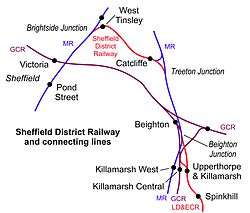Sheffield District Railway

The Sheffield District Railway was a railway line in South Yorkshire, England.
| Sheffield District Railway | ||||||||||||||||||||||||||||||||||||||||||||||||||||||||||||||||||||||||||||||||||||||||||||||||||||||||||||||||||||||||||||||||||||||||||||||||||||||||||||||||||||||||||||||||||||||||||||||||||||||||||||||||||||||||||||||||||||||||||||||||||||||||||||||||||||||||||||||||||||||||||||||||||||||||||||||||||||||||||||||||||||||||||||||||||||||||||||||||||||||||||||||||||||||||||||||||||||||||||||||||||||||||||||||||||||||||||||||||||||||||||||||||||||||||||||||||||||||||||||||||||||||||||||||||||||||||||||||||||||||||
|---|---|---|---|---|---|---|---|---|---|---|---|---|---|---|---|---|---|---|---|---|---|---|---|---|---|---|---|---|---|---|---|---|---|---|---|---|---|---|---|---|---|---|---|---|---|---|---|---|---|---|---|---|---|---|---|---|---|---|---|---|---|---|---|---|---|---|---|---|---|---|---|---|---|---|---|---|---|---|---|---|---|---|---|---|---|---|---|---|---|---|---|---|---|---|---|---|---|---|---|---|---|---|---|---|---|---|---|---|---|---|---|---|---|---|---|---|---|---|---|---|---|---|---|---|---|---|---|---|---|---|---|---|---|---|---|---|---|---|---|---|---|---|---|---|---|---|---|---|---|---|---|---|---|---|---|---|---|---|---|---|---|---|---|---|---|---|---|---|---|---|---|---|---|---|---|---|---|---|---|---|---|---|---|---|---|---|---|---|---|---|---|---|---|---|---|---|---|---|---|---|---|---|---|---|---|---|---|---|---|---|---|---|---|---|---|---|---|---|---|---|---|---|---|---|---|---|---|---|---|---|---|---|---|---|---|---|---|---|---|---|---|---|---|---|---|---|---|---|---|---|---|---|---|---|---|---|---|---|---|---|---|---|---|---|---|---|---|---|---|---|---|---|---|---|---|---|---|---|---|---|---|---|---|---|---|---|---|---|---|---|---|---|---|---|---|---|---|---|---|---|---|---|---|---|---|---|---|---|---|---|---|---|---|---|---|---|---|---|---|---|---|---|---|---|---|---|---|---|---|---|---|---|---|---|---|---|---|---|---|---|---|---|---|---|---|---|---|---|---|---|---|---|---|---|---|---|---|---|---|---|---|---|---|---|---|---|---|---|---|---|---|---|---|---|---|---|---|---|---|---|---|---|---|---|---|---|---|---|---|---|---|---|---|---|---|---|---|---|---|---|---|---|---|---|---|---|---|---|---|---|---|---|---|---|---|---|---|---|---|---|---|---|---|---|---|---|---|---|---|---|---|---|---|---|---|---|---|---|---|---|---|---|---|---|---|---|---|---|---|---|---|---|---|---|---|---|---|---|---|---|---|---|---|---|---|---|---|---|---|---|---|---|---|---|---|---|---|---|---|---|---|---|---|---|---|---|---|---|---|---|---|---|---|---|---|---|---|---|---|---|---|---|---|---|---|---|---|---|---|---|---|---|---|---|---|---|---|---|---|---|
Legend | ||||||||||||||||||||||||||||||||||||||||||||||||||||||||||||||||||||||||||||||||||||||||||||||||||||||||||||||||||||||||||||||||||||||||||||||||||||||||||||||||||||||||||||||||||||||||||||||||||||||||||||||||||||||||||||||||||||||||||||||||||||||||||||||||||||||||||||||||||||||||||||||||||||||||||||||||||||||||||||||||||||||||||||||||||||||||||||||||||||||||||||||||||||||||||||||||||||||||||||||||||||||||||||||||||||||||||||||||||||||||||||||||||||||||||||||||||||||||||||||||||||||||||||||||||||||||||||||||||||||||
| ||||||||||||||||||||||||||||||||||||||||||||||||||||||||||||||||||||||||||||||||||||||||||||||||||||||||||||||||||||||||||||||||||||||||||||||||||||||||||||||||||||||||||||||||||||||||||||||||||||||||||||||||||||||||||||||||||||||||||||||||||||||||||||||||||||||||||||||||||||||||||||||||||||||||||||||||||||||||||||||||||||||||||||||||||||||||||||||||||||||||||||||||||||||||||||||||||||||||||||||||||||||||||||||||||||||||||||||||||||||||||||||||||||||||||||||||||||||||||||||||||||||||||||||||||||||||||||||||||||||||
Its main line ran between Brightside Junction,[1] on the Midland Railway's Sheffield to Rotherham line, and Treeton Junction,[2] on the same company's Rotherham to Chesterfield line (the "Old Road"). The Sheffield and District's main line was 3.5 miles (6 km) long[3] and had two stations, Tinsley Road, which was later renamed West Tinsley, and Catcliffe.
The line is described by Dow as "the LD&ECR's satellite"[4] as it was that company's brainchild and their means to enter Sheffield. It gave the LD&ECR passenger access to Sheffield Midland but, more importantly, it gave them and through them, the Great Eastern Railway, access to freight facilities in Sheffield.
Construction
Building of the line started on 20 November 1896 when the Duke of Norfolk cut the first sod.[3] The line was opened on 21 May 1900 by the Duke of Portland, with passenger services starting on 30 May 1900.[5]
This short line included substantial embankments, the 80 yards (73 m) Tinsley Wood Tunnel and no fewer than 18 bridges and viaducts.
Notably, the line spanned:
- the River Rother at Catcliffe by a 40 ft arch, plus eight other 30 ft arches
- the GCR's Sheffield to Barnsley line near Tinsley Wood by a massive lattice-girder bridge, and
- the River Don at Brightside by a viaduct consisting of:
- six 30 ft spans followed by a
- a lattice girder bridge.
Finally, also at Brightside, it crossed
Operation
The line was operated by the LD&ECR and after its takeover on 1 January 1907 by the Great Central Railway (GCR) although it had no physical connection with any other part of their systems. Running powers over other companies' metals were used to reach the line and its facilities. It was integrated into the London and North Eastern Railway (LNER) in 1923.
Passenger services along the SDR's main line continued:
- until 11 September 1939 between Sheffield and Mansfield via the LD&ECR's Beighton Branch, and
- until 11 September 1939 between Sheffield and Chesterfield the "long way round" via the "Old Road", with a brief revival from 6 October 1946 to 17 March 1947.[8]
Goods lines
The company had two substantial goods depots and warehouses, with connections to others.
- Attercliffe Depot was built by diverting the River Don and infilling a quarter of a million cubic yards of soil. To access it a 1,100 yards (1,006 m) branch was built from a new Sheffield District Junction 154 yards (141 m) south of Grimesthorpe Junction on the Midland Railway's Sheffield to Rotherham line. It was served by Stevenson Road, Faraday Road and Pricess Street.[9]
- West Tinsley Goods yard was built at road level at the end of a steep 590 yards (539 m) branch adjacent to Tinsley Road (later renamed West Tinsley station. This connection also served Edgar Allen and Company's Imperial Steel Works.
- Several other short branch lines, all opened in 1903, left the line to serve the local industrial concerns including Cooper & Co, Hadfield's Steel Foundry, William Jessop and Sons, Sanderson Brothers & Newbould and Woodhouse and Rixson. The longest branch line, over 1 mile (2 km) in length, served Tinsley Park Colliery.[7][1]
The line today
The line is now only used between Tinsley South Junction and Tinsley Yard, opened in 1965.
References
- Butt, R. V. J. (1995). The Directory of Railway Stations: details every public and private passenger station, halt, platform and stopping place, past and present (1st ed.). Sparkford: Patrick Stephens Ltd. ISBN 1-8526-0508-1. OCLC 60251199.
- Cupit, J.; Taylor, W. (1984) [1966]. The Lancashire, Derbyshire & East Coast Railway. Oakwood Library of Railway History (2nd ed.). Headington: Oakwood Press. ISBN 0-85361-302-8. OL19.
- Dow, George (1965). Great Central, Volume Three: Fay Sets the Pace, 1900-1922. Shepperton: Ian Allan. ISBN 0-7110-0263-0. OCLC 500447049.
- Pixton, Bob (2001). North Midland: Portrait of a Famous Route: Part 2 Chesterfield-Sheffield-Rotherham. Nottingham: Runpast Publishing, (now Book Law). ISBN 1 870754 51 4.